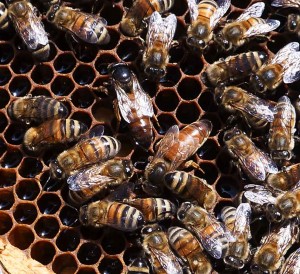We’ve all heard a bee colony only has one queen. We read it in bee books. But bees don’t read our books. So they don’t know. Mostly it’s the correct description, with one queen ina bee colony, but not always.
In the middle of August last year I saw a colony having only drone brood and made a note. I came back some days later for another reason to that apiary and looked in the colony again. I happened to spot what looked like a new laying queen. Could she be the cause of the drone brood. I had to think about what to do, so I closed the colony again. Maybe it was the first brood of her. Sometimes it’s drone brood. Maybe the weather had been bad and she hadn’t been able to mate and the bees fed her to start laying. That happens. Weather had been unfavourable for mating.
In Sweden it was pretty late in our short season. I had some small mating nucs from which the queens had been taken and they had made a queen of their own in that mini nuc. I decided to make an experiment. I didn’t take time to find the queen that probably had been laying the drone brood, a quite yellow one. But I took the mini nuc queen, darker than the queen of the colony, and put her on a drone brood frame I had layed on the side with the bees on it, poured liquid honey all over the queen. The bees started to lick her and the honey went off the queen as she is quite hairy. I poured on more honey, And more honey. Then I thought it was enough and put the frame back in place and closed the colony. My idea was to try this type of queen introducing method and thought that the bees probably were smart enough to choose the best one and keep her, as the other one probably were not good enough.
31 August I found some good looking capped brood, but I dind’t know which queen layed it. But I also found out that the mini nuc was supplied with a small queen excluder which had been covering the entrance. Had the mini nuc queen really mated, but I had seen eggs in the mini nuc. Later I saw they turned out to be drone brood! So the honey introduced queen couldn’t be responsible for the good brood. Probably she was killed. I would find out in spring. I made a note in my note book
This spring this colony didn’t perform well, but it had survived in spite of many old bees in autumn and not many young good winter bees.
I found two queens on the same side of the comb when I looked. The light colored queen was there. But the other one was not the introduced one. It was not as dark, just a little darker than the light one. The darker one was very beaten of bees. No hair on the head or thorax, and the wings were teared. But she was fed, apparently the retired mother of the new one. Beekeeping is fun.

It seems that ants have something to teach in this.In reading about ant Queen lifestyles some say after mating flight the ant queens wings fall off.Others say that a caste(soldiers possibly) in ant colonys attack and maul the new queen and bite and tear her wings off.It is common in ant colonys for there to be more then one wingless queen Are you triggering leftover genetic memories in honeybee from ants? Thank you Mr Osterlund for all you do to enrich are honey bees in northern new england u.s.a. regards Kennedy